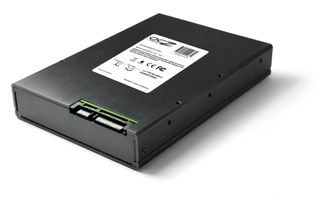Solid State Drive Buyer's Guide
Should you consider upgrading to a solid state drive? Weigh all the pros and cons and evaluate the cost and value of doing so by reading this guide.
Breakdown, Continued
We’re guessing that a lot of mainstream buyers can wrap their heads around a $150 or $200 SSD, maybe even $300, but $500 is starting to stretch the limits of budgets and reason. If we break those hours saved down into cost-per-hour, suddenly we’re looking at white collar wages. At this level, you have to be looking at application performance and it’s time to start examining IOPS performance. When you read benchmark-driven SSD reviews, input/output operations per second (IOPS) figure heavily because this is where SSDs most dramatically show their differences. It’s also the metric that enterprises use when assessing server performance.

As mentioned already, though, IOPS as a measure of performance may not be applicable to most consumers (gamers possibly excepted). The more pertinent factor in the $500 category may be TRIM support along with total capacity. TRIM compatibility is going to provide that big jump in write performance, and the 160GB capacity level is where many laptop owners stuck with having only one internal drive may have to turn. The latest 34 nm-based 80GB Intel X25-M is expected to settle around a $250 price tag going into the holidays, and that does support TRIM. The question is whether 80GB will be enough capacity for some buyers. Also note that both X25-M generations top out at 70 MB/sec on sequential writes. The Vertex and its ilk measure in the 100 to 120 MB/sec range.

There are plenty of other SSD options. OCZ, for example, makes its Z-Drive line, which plants 250GB to 1TB of storage on a conventional PCI Express card but is priced well beyond mainstream. The company also has its Colossus series of 3.5" SSDs, due to land in North America this month with price points under $3 per gigabyte. In both cases, though, these are still new and relatively niche entries. Today, the 2.5" form factor dominates the SSD market for PCs. If you’re installing into a desktop system, you may need to either pay for a 2.5"-to-3.5" adapter carrier or else look for a retail bundle featuring a drive with a carrier. We don’t recommend duct taping the drive to the inside of your case...although it would probably work, too.
The bottom line is that SSD pricing has now come down so far—especially thanks to Intel’s massive price drops with the G2 release—that the drives are within reach of practically anyone. The base-level bed of benefits SSD delivers make the technology almost irresistible, if only as a low-capacity boot drive. You’ll need to juggle the factors of storage space, various performance specs, TRIM compatibility, controller quality, and pricing in order to narrow down the field and find the drive that’s right for you, but the incentives are now worth the effort of studious shopping. Once you make the solid state jump, you’ll never go back. It’s that good.
Sign up to get the BEST of Tom's Guide direct to your inbox.
Get instant access to breaking news, the hottest reviews, great deals and helpful tips.
Current page: Are SSDs Worth It? - Yes, They Really Are That Good - Tom’s Guide
Prev Page How to Buy an SSD - Things to Consider - Tom’s GuideWilliam Van Winkle is a freelance editor and tech journalist who has been writing for more than 20 years. His work has appeared on Tom's Guide, Tom's Hardware, Tom's IT Pro, AMD, Seagate, Computer Shopper, and more. He is also an author, writing poetry, short stories, and science fiction and fantasy books.
-
Shadow703793 Imo, I'd keep away with any SSD drive using a JMicron. Dosen't matter if the stutering,etc issues were fixed. Indylinx and Intel controllers are the best right now.Reply
Anyways, I got an X25-M G2 (OEM) for $220 @Newegg during Black Friday. -
grimjester The point about getting a small SSD for software and a larger disk for data can't be stressed enough. The price per GB looks completely different if you only need 64G. There's little difference in price between the cheapest hard drive you can get and the cheapest 500G one.Reply
An SSD is just an extra cost of $150-300. It has no practical effect on the storage space your computer has. -
Eggrenade I wouldn't say it's better than Anandtech's; there's no mention of random reads or writes, which is why performance just after startup is so good. It's also a lot less technical, which is probably better for most Tom's Guide readers.Reply -
Tomsguiderachel EggrenadeI wouldn't say it's better than Anandtech's; there's no mention of random reads or writes, which is why performance just after startup is so good. It's also a lot less technical, which is probably better for most Tom's Guide readers.Exactly :)Reply -
Tomsguiderachel nonxcarbonxThis is an even better ssd article than anandtech's ssd anthology. Nice work.Thank you. I hope it was a good fit for Tom's Guide readers' needs.Reply -
Next page broken http://www.tomsguide.com/us/ssd-value-performance,review-1455-11.html, sorry couldnt find anywhere to submit feedback. Page not working on firefox 3.5.5 (does not scroll).Reply
-
Tomsguiderachel none007Next page broken http://www.tomsguide.com/us/ssd-va 55-11.html, sorry couldnt find anywhere to submit feedback. Page not working on firefox 3.5.5 (does not scroll).I'm using the same browser and that page works for me. I will report the bug, thanks.Reply -
Tomsguiderachel TomsguiderachelI'm using the same browser and that page works for me. I will report the bug, thanks.Oh--I see that you mean the final page of the article not the penultimate page. FYI There is no content on that last page so you didn't miss part of the article.Reply -
tommysch I think Ill stick to my 4x1TB RAID 0 array for now. BTW they are ghosted each week. o_0Reply
